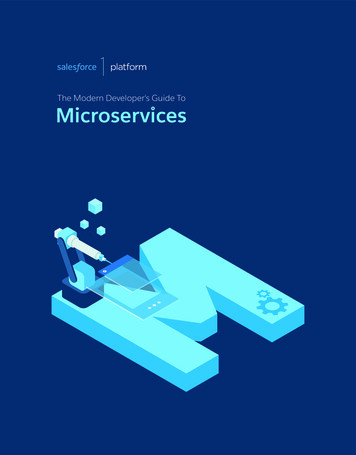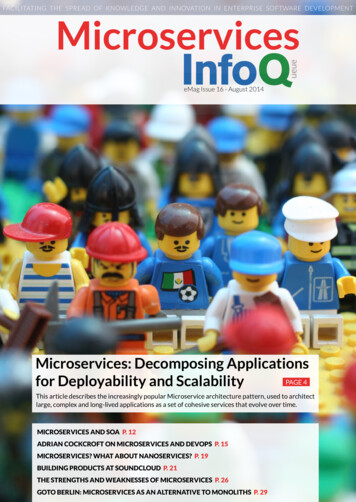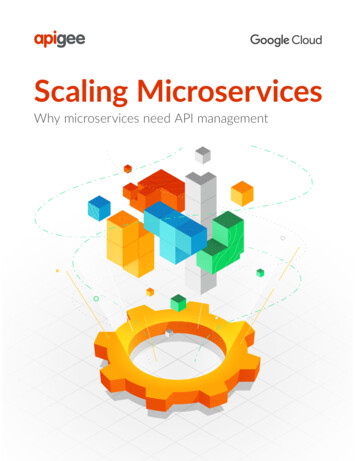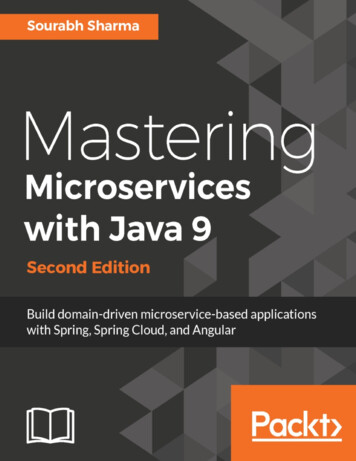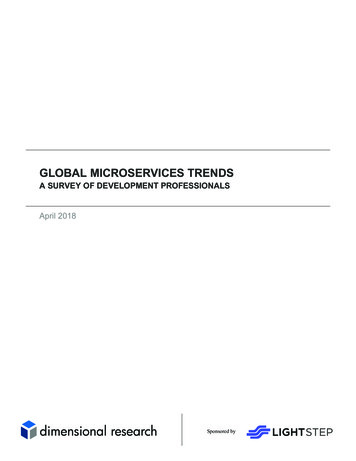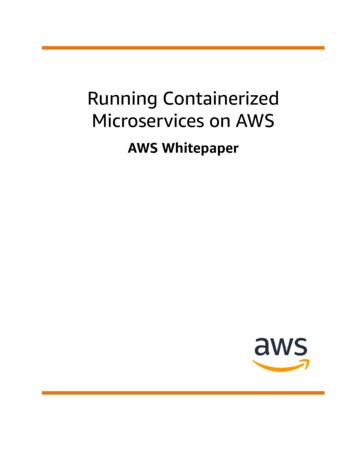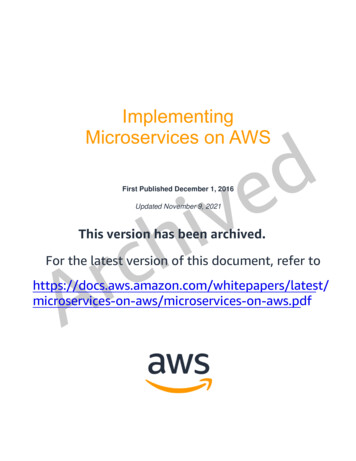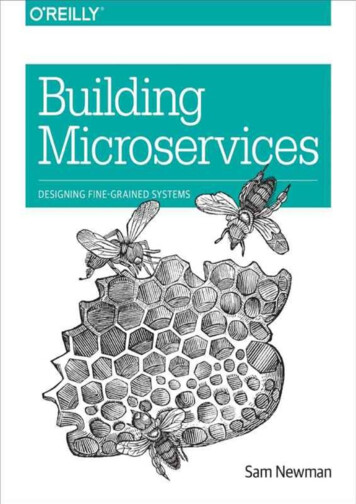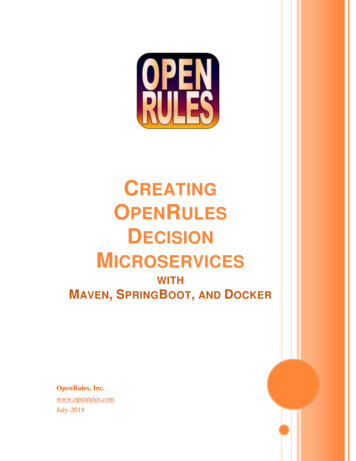
Transcription
CREATINGOPENRULESDECISIONMICROSERVICESWITHMAVEN, SPRINGBOOT, ANDOpenRules, Inc.www.openrules.comJuly-2019DOCKER
OpenRules, Inc.OpenRules Web ServicesTABLE OF CONTENTSIntroduction .3What You’ll Do.3What Should Be Pre-Installed .4Mavenizing OpenRules Configuration.4Creating a Maven OpenRules Project in Eclipse .6Defining Decision Model .7Adding a Java Interface. 11Creating Spring Boot Web Application. 16Adding Service to Spring Boot Application . 18Testing Decision Service with POSTMAN . 22Testing Decision Service with a Java Client . 24Adding Another OpenRules Decision Service . 25Deploying Decision Service to Docker . 35Conclusion . 36Technical Support . 362
OpenRules, Inc.OpenRules Web ServicesINTRODUCTIONNowadays microservices quickly become a highly popular architectural approach. They haveshown essential advantages over the legacy style of monolithic single applications: Easy deployment Simple scalability Compatible with Containers and cloud environments Minimum configuration Lesser production time.It’s only natural to deploy Business Decision Models created and tested by business users asdecision microservices. This tutorial provides a sampling of how to build Decision Microserviceswith Spring Boot and OpenRules and containerize them with Docker.WHAT YOU’LL DOWe will explain what you need to do to create, test, and deploy an OpenRules-based decisionservice using SpringBoot and Docker. We will assume that you are familiar with Java and EclipseIDE and have a high-level understanding of the Spring framework and Docker.Following step-by-step instructions below, you do the following: “Mavenize” the standard OpenRules configuration Create a simple Maven project in Eclipse which will be used to invoke OpenRules-basedservice with business logic represented in Excel decision tables Test this from Java Convert this decision service to a simple REST web application built using Spring Bootand test it with POSTMAN using JSON Containerize this decision service using Docker and test it using POSTMAN and/or aJava-based client.3
OpenRules, Inc.OpenRules Web ServicesIn the end, you will be ready to create and containerize your own OpenRules decision services.WHAT SHOULD BE PRE-INSTALLEDWe assume that you’ve already installed: Java 1.8 or later Eclipse IDE Maven OpenRules evaluation (or complete) version by downloading the workspace“openrules.models” Docker Desktop.When all these products are installed, start Eclipse with a new workspace called“openrules.services”.MAVENIZING OPENRULES CONFIGURATIONThe standard OpenRulesinstallation workspace “openrules.models” contains a specialconfiguration project called “openrules.config” and a set of sample projects such as“VacationDays”. Import the standard OpenRules configuration project “openrules.config” fromthe workspace “openrules.models” to the already opened workspace “openrules.services”.We are going to use Maven as our main building tool, so first we need to “mavenize” thisOpenRules configuration. We will install all jar-files from “openrules.config/lib” to the localMaven’s repository, that is a directory on your computer where Maven holds all artifacts anddependencies. To do that, first we will add the following “pom.xml” file to “openrules.config”:4
OpenRules, Inc.OpenRules Web ServicesNote that along with necessary jar-files, we configured a rule repository called “rules” as a“resource” folder, so that the content of this folder will be packaged into created jars along withclasses, properties files and other resources, and will be used by all decision services we plan toadd to this Maven configuration.Now we will add the following file “install.bat” to “openrules.config”:5
OpenRules, Inc.OpenRules Web ServicesNow you may right-click on this file and select “Open With System Editor” – alternatively youmay double-click on this file from File Explorer or just execute 4 commands used inside this filedirectly from a command line. It will build OpenRules Config 7.0.1-SNAPSHOT in your localMaven repository (but you don’t even need to look at it). Your Maven is ready to work withOpenRules.CREATING A MAVEN OPENRULES PROJECT IN ECLIPSENow we will create a Maven project for the OpenRules service “VacationDays”. From you EclipseFile-menu, select File New Project Maven Project:6
OpenRules, Inc.OpenRules Web ServicesClick “Next” and enter the Artifact data as below. For the Parent project click on “Browse.”,start typing “openrules” and make the selections as on the right image:DEFINING DECISION MODELWe want to build a simple decision model that calculates the number of vacation days given toan employee based on the age and years of service. Here are the business rules:7
OpenRules, Inc.OpenRules Web ServicesYou already can find the proper decision model implemented in the standard OpenRulesworkspace “openrules.models” as a stand-alone project “VacationDays”. In that project thedecision model was defined in the rules repository called “rules” and use the standardOpenRules templates defined in the configuration project “openrules.config”.For the Maven-based decision services we already decided to use the common rules repositorycalled “rules” which we added as a dependency to the file “openrules.config/pom.xml”. So, nowwe will create the folder “rules” in our new Maven’s project “VacationDays”. Then we will addtwo sub-folders to the folder “rules”: templates – a placeholder for the standard OpenRules templates vacationDays – a placeholder for our decision model “VacationDays”.So, now we will copy files “openrules.config/DecisionTemplates.xls” es.xls” into the subfolder “templates”. Then wewill copy all Excel files from the folder “openrules.models/VacationDays/rules” to the subfolder“vacationDays”. Here are Excel files and tables that implement vacation days calculation logic.File “rules/vacationDays/Rules.xls”:8
OpenRules, Inc.OpenRules Web ServicesAll decision goals, variables, and user Decision objects are defined in the file “rules/vacationDays/Glossary.xls”:The structure of this decision model was defined in the file “DecisionModel.xls” in thisEnvironment table that used to look as below:9
OpenRules, Inc.OpenRules Web ServicesThe third include-statement referred to the standard templates located two levels above the oldproject “VacationDays”. Now we keep these templates in the subfolder “templates” that is onthe same level as the folder “vacationDays”. So, we need to adjust the Environment table asfollows:The folder “rules/vacationDays” also include the file “Test.xls” that specifies Datatype“Employee” and creates several test-cases with expected results. To make sure that the newdecision model still works, copy file “build.bat” and “run.bat” fromopenrules.models/VacationDays/ to our new project “VacationDays”, and make the followingchanges in them:File “build.bat”:File “run.bat”:These bat-files use openrules.config’s file projectBuild.bat and projectRun.bat. Both these filesreferred to compiles classes using set CLASSES ./bin. However, in the Maven’s projectscompiled classes are created not in “bin”, but rather in “target”. So, we need in both these bat-10
OpenRules, Inc.OpenRules Web Servicesfiles replace the setting toset CLASSES ./target/classes;./target/test-classesNow, we can double-click on “build.bat” and it will build an execution path for this model andwill save it in the file “Goals.xls”. Then double-click on “run.bat” and it will execute all test-casesproducing the following results:ADDING A JAVA INTERFACETo execute the same model from Java, we will create 3 Java classes: Employee.java – to define test-employees VacationDaysService.java – to specify our service Test.java – to test the service locally.So first, we create a new Java package “com.openrules.vacation” in the folder “src/maim/java”:11
OpenRules, Inc.OpenRules Web Servicesand then add a new class Employee:The class “Employee” will contain the same attributes that were used in the above Glossary andthe Datatype table “Employee”:12
OpenRules, Inc.OpenRules Web ServicesThen we will right-click on “Employee.java” and use “Source” ”Generate Getters and Setters” “Generate toString()” to complete this class. Here is the class “VacationDaysService”:Note, that we refer to main Excel file in the rules repository as “classpath:/Goals.xls”. It meansall Excel files that our folder “rules” also should be in the Maven classpath. This has been alreadyguaranteed when we added the dependency for “rules” to the “pom.xml”.Now, we are ready to test our modified decision model “VacationDaysService”. The tests shouldbe placed to the automatically created folder “src/test/java”. So, we will add here a newpackage “com.openrules.vacation”, and then we will add to this package a new class“Test.java”:13
OpenRules, Inc.OpenRules Web ServicesRight-click on the file “Test.java” and select “Run As Java Application”. It will produce the resultsthat look like below:We may consider that our decision service “VacationDays” has been tested as a stand-aloneapplication and is ready for further deployment. Our Eclipse project now looks as below:14
OpenRules, Inc.OpenRules Web ServicesTo complete its Maven’s installation, we should right-click on “VacationDays/pom.xml” andselect “Run As” “Maven Install”.Now it’s time to migrate this service to a REST web-based application using Spring Boot.15
OpenRules, Inc.OpenRules Web ServicesCREATING SPRING BOOT WEB APPLICATIONThe simplest way to create a Spring Boot project is to use Spring Initializr. To bootstrap your newSpring Boot project, open https://start.spring.io/ and enter the following data:When you click on “Generate Project”, Spring Initializr will create and download the file“spring.zip” into your Downloads folder. Extract the downloaded zip file into your Eclipse16
OpenRules, Inc.OpenRules Web Servicesworkspace folder “openrules.services”. In the Eclipse select “File Import Project ExistingMaven Projects”:It will create a new project “spring”. This project already contains the file “Application.java”:17
OpenRules, Inc.OpenRules Web ServicesThis is the main application class with @SpringBootApplication annotation for our future SpringBoot application. If you right-click on this file “Application.java” and select “Run as JavaApplication” the Spring Boot will start the embedded Tomcat server, deploy the application onthe Tomcat, and will wait for HTTP requests on the port “localhost:8080”. But this applicationdoesn’t have any services yet. In the next section, we will add our VacationDaysService to thisweb application.ADDING SERVICE TO SPRING BOOT APPLICATIONTo add different services to this application, we need to create a Java class called a RESTController that may include different services waiting to be executed upon the proper HTTPrequest. We will call our REST Controller “VacationDaysController” and it will include our servicedefined in the project “VacationDaysService”. To make sure that the Spring Boot project“spring” is aware of our project “VacationDaysService”, right-click on “spring/pom.xml” andselect Maven Add Dependency. It will open this dialog:18
OpenRules, Inc.OpenRules Web ServicesStart typing “openrul” in the box “Enter groupId, ” and it will show available results. Select“com.openrules.samples VacationDays” and Group ID, Artifact Id” and “Version” will be filledout automatically. After you click OK, Eclipse will add the following dependency to the file“spring/pom.xml”:Of course, you could add them manually as well.Now we can create a new Java class “VacationDaysController” in the same package“com.service.spring” where SpringBoot placed the above class Application. Here is the initialversion:19
OpenRules, Inc.OpenRules Web ServicesHere we use Spring Boot dependency injection facilities by adding an annotation @Autowired tothe definition of our service. When you type Eclipse will automatically add the correspondingimports.To handle the incoming HTTP requests for our service, this controller should include a methodthat will accept an Employee object as a parameter and returns a calculated number of vacationdays for this employee.The method “calculateVacationDays” will be automatically called when our web applicationreceives a POST request through the URL “/vacationDays” with a JSON object that has the sameproperties as the class Employee. To define this functionality, we used Sprint Boot annotations@RequestMapping and @RequestBody:@RequestMapping( path ”/vacationDays”, method {RequestMethod.POST})public int calculateVacationDays( @RequestBody Employee employee) {.}We are not done yet. To “autowire” this service, we need to inform Spring how to create aninstance of the class VacationDaysService. It’s usually done within a special class annotated ofthe type @Configuration. So, we need to create a new class “ServiceFactory” annotated it with@Configuration. For each service this class should include a method annotated with @Beanthat creates and returns an instance of the service. In our case it will be the method“newVacationDaysService” as described below:20
OpenRules, Inc.OpenRules Web ServicesThis completes the development of our Spring Boot application with one service that will becalled using URL “/vacationDays”.To test our web application, right-click on “Application.java” and select “Run As JavaApplication”. It will start the embedded Tomcat, deploy the latest version of our spring project,and will wait to HTTP requests. Here is the protocol from the Eclipse’s Console view: At the end of the protocol in the right bottom corner you should see that Spring started ourservice:21
OpenRules, Inc.OpenRules Web ServicesNow our web application is running and waiting for HTTP requests.TESTING DECISION SERVICE WITH POSTMANTo create HTTP requests for this web application, we will use POSTMAN, a popular tool that canbe downloaded for free from https://www.getpostman.com/. After installation and start, youmay fill out this POSTMAN’s form:22
OpenRules, Inc.OpenRules Web ServicesIn this form, we selected the method “POST” (from the drop-down list), typed the URL“localhost:8080/vacationDays”, enter a simple JSON structure{“age”: 55“service”: 22}After, a click on “Send”, the POSTMAN sent the proper HTTP request to our web application,that executed our VacationDaysService and returned the calculated number of vacation days“24” at the bottom of the form. We may enter different combinations of “age” and “service” tomake sure that our OpenRules-based VacationDaysService works as expected.23
OpenRules, Inc.OpenRules Web ServicesTESTING DECISION SERVICE WITH A JAVA CLIENTNow we may test our running service from any Java program similar to what we did withPOSTMAN. Spring has already prepared for us the place for all Java tests: the package“com.service.spring” in the folder “src/test/java”. Let’s add a new Java class“VacationDaysClient” to this package. It may look as below:As you can see, we create a string with the same JSON data as we used in POSTMAN. Then weopen a connection using the URL “http://localhost:8080/VacationDays”. When we write ourJSON data to the connection’s output stream, it sends the proper HTTP request to our service.And then we simply read the produced results from the connection’s input stream.As our service is still up and waiting, we may simply right-click on the “VacationDaysClient.java”and select “Run As Java Application”. After executing the request, it will display the same 24days.24
OpenRules, Inc.OpenRules Web ServicesADDING ANOTHER OPENRULES DECISION SERVICESimilarly to the service “VacationDays”, we can move more services from “openrules.models” toour workspace “openrules.services”. Let’s start with the rules project Hello.We will create a simple Maven project “Greeting”:Defining Decision ModelWe can find the proper decision model implemented in the standard OpenRules workspace“openrules.models” as a stand-alone project “Hello”. First, we create a new rules repository inthe folder “rules” in our new Maven’s project “Greeting”. We may copy the subfolder“templates” from the VacationDays/rules/templates into “rules”. Then we will create asubfolder “greeting” inside “rules”. Then we will copy all Excel files from the folder“openrules.models/Hello/rules” to the subfolder “greeting”. Here are Excel files and tables thatimplement vacation days calculation logic.File “rules/greeting/Rules.xls”:25
OpenRules, Inc.OpenRules Web ServicesAll decision goals, variables, and decision objects are defined in the file“rules/greeting/Glossary.xls”:The file “rules/greeting/DecisionModel.xls” contains the modified Environment table:26
OpenRules, Inc.OpenRules Web ServicesThe folder “rules/greeting” also includes the file “Test.xls” that specifies Datatype “Customer”and creates several test-cases with expected results. To make sure that the new decision modelstill works, we copy file “build.bat” and “run.bat” from openrules.models/Hello/ to our newproject “Greeting”, and make the following changes in them:File “build.bat”:File “run.bat”:Double-click on “build.bat” and it will build an execution path for this model and will save it inthe file “Goals.xls”. Then double-click on “run.bat” and it will execute all test-cases producingthe expected results.Adding a Java InterfaceTo execute the same model from Java, we will create 3 Java classes: Customer.java – to define test-employees GreetingService.java – to specify our service Test.java – to test the service locally.So first, we create a new Java package “com.openrules.greeting” in the folder “src/main/java”and then add a new class Customer:27
OpenRules, Inc.OpenRules Web ServicesThen we will use Eclipse to generate Getters and Setters and toString() methods for this class.Then we add a new class “GreetingService”:To test this modified decision model, we will add here a new package “com.openrules.greeting”to “src/test/java/, and then we will add to this package a new class “Test.java”:28
OpenRules, Inc.OpenRules Web ServicesRight-click on the file “Test.java” and select “Run As Java Application”. It will produce the resultsthat look like below:We may consider that our decision service “Greeting” has been tested as a stand-aloneapplication and is ready for further deployment. To complete Maven’s installation for thisproject, we should right-click on “Greeting/pom.xml” and select “Run As” “Maven Install”.Now it’s time to migrate this service to a REST web-based application using Spring Boot.Adding Greeting Service to Spring Boot ApplicationWe will continue to use the same Spring Boot project ”spring” that we created earlier.The file “Application.java” remains without changes. Now we want to add a new“GreetingService” based on our project “Greeting”. To make sure that the Spring Boot project“spring” is aware of our project “Greeting”, right-click on “spring/pom.xml”, select Maven AddDependency, and fill out this dialog:29
OpenRules, Inc.OpenRules Web ServicesAfter you click OK, Eclipse will add the following dependency to the file “spring/pom.xml”:Now we can create a new Java class “GreetingController” in the same package“com.service.spring” where we placed “VacationDaysController”. Here is this class:30
OpenRules, Inc.OpenRules Web ServicesThe method “produceGreetingFor” will be automatically called when our web applicationreceives a POST request through the URL “/greeting” with a JSON object that has the sameproperties as the class Customer.To “autowire” this service, we need to add the method “newGreetingService” (the name is up tous) to the class “ServiceFactory”. This method will create and return an instance ofGreetingService. Here is the modified class “ServiceFactory”:Now our Spring Boot application can handle two services: VacationDays and Greeting.To test these services, we will start our application by right-clicking on “Application.java” andselect “Run As Java Application” – make sure that you stopped previous applications which usethe same port.31
OpenRules, Inc.OpenRules Web ServicesNow our web application is running and waiting for HTTP requests for services with URLs:“localhost:8080/vacationDays” and “localhost:8080/greeting”. If you run POSTMAN with theseURLs and the proper JSON data, it will produce the expected results. We also may add a Javaclient in the class GrretingServiceClient in src/test/java/:When you run this class as Java Application, it will produce: ”Good Morning, Mrs.Robinson!”.To prepare our SpringBoot application for further deployment, we need to right-click on“spring/pom.xml” and select “Run As” “Maven install”. It will .1-SNAPSHOT.jar to the Maven’s repository. We justneed to check the “Maven install” will be completed with the message “BUILD SUCCESS”. Here isthe latest structure of the project “spring”:32
OpenRules, Inc.OpenRules Web ServicesPlease note that the jar-file SHOT.jarcompletely encapsulates everything we need to run our deployed decision services“VacationDays”, “Greeting”, and any other services we may add. And you don’t need to run“Application.java” from Eclipse. Let’s stop this application in Eclipse. Let’s open a command linewindow in the folder “openrules.services\spring”. Now we may enter the following command:It will start our REST web application, initialize both “Greeting” and “VacationDays” services, andwait for HTTP requests. Here is the start protocol:33
OpenRules, Inc.OpenRules Web ServicesNow again we may send HTTP requests from POSTMAN or from our Java clients or from similarprograms, and they will work as before. You actually may move spring-0.0.1-SNAPSHOT.jar toany other location and it will work as well. It’s also ready to be uploaded to AWS or anothercloud repository, and invoke our decision services remotely.34
OpenRules, Inc.OpenRules Web ServicesDEPLOYING DECISION SERVICE TO DOCKERNow it’s time to containerize our decision service using Docker. We are going to use the sameport, so let’s stop the running Application by clicking on the red rectangle in the Eclipse bar with“Console”.We need to add the following file “Dockerfile” to the folder “openrules.services/spring/”:This file will be used to build a Docker image from the command line. To do this, we will use acommand line starting from the “openrules.services/spring/”.Enter the following command:It will build the Docker image of our Spring application and will call it “openrules.samples”. Hereis the execution protocol:To run our application from the newly created container, we may enter the command:35
OpenRules, Inc.OpenRules Web ServicesIt will show the temporary name of the started docker’s process, and our application is readyagain to handle HTTP requests. We can do it either from POSTMAN or from VacationDaysClientand still will receive the same results as before.Now you can use orchestration tools such as Kubernetes for of the Docker containers withOpenRules decision services. The created Docker images can be deployed to any cloudenvironment that supports Docker containers: AWS, Google Cloud, MS Azure, IBM Cloud,Rackspace, and many others.CONCLUSIONIn this tutorial we demonstrated how to migrate OpenRules decision models to Maven. Then wecreated a Sprint Boot REST application with several OpenRules-based decision models deployedas decision services. We had shown how to test this decision services using by sending HTTPrequests with JSON data using the POSTMAN or Java-based clients. And finally, we containerizedthis Spring Boot web application using Docker.TECHNICAL SUPPORTDirect all your technical questions to support@openrules.com or to this Discussion Group.36
decision microservices. This tutorial provides a sampling of how to build Decision Microservices with Spring Boot and OpenRules and containerize them with Docker. . We are going to use Maven as our main building tool, so first we need to "mavenize" this OpenRules configuration. We will install all jar-files from "openrules.config/lib .
